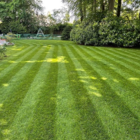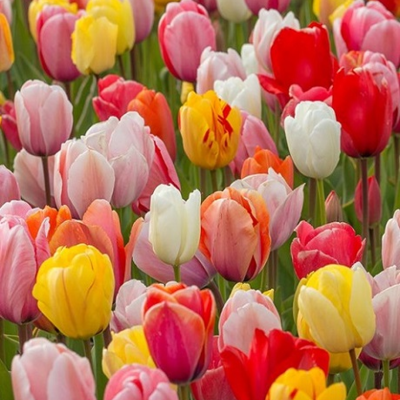BS Shady Place Grass Seed
Designed specifically to produce a quality turf in shaded areas. BS Shady Place grass seed is perfect for under trees, alongside fences and hedgerows. Our shade-tolerant grass seed varieties are particularly well-suited to dry shade areas and lower fertility areas. For wet shade areas, choose BS Childs Play Lawn Seed.
- Retains a lush, green appearance in areas of low sunlight (images are actual photos of a BS Shady Place new lawn sowings).
- Low maintenance and slow-growing.
- Use in dry or low-nutrient shaded areas.
- Contains: 27% amenity perennial ryegrass, 55% strong creeping red fescue, 10% slender creeping red fescue, 5% smooth-stalked meadow grass and 3% highland bent.
- DEFRA-certified for exceptionally high purity and germination.
- Sow at 35 grams per sq/m - 20kg covers 570sq/m.
- For best results, use with Pre-Seeding Fertiliser and a spreader.
Mixture Specification
Grass Seed for Shaded Area Mixture Specification
What is in grass seed for shade? BS Shady Place Grass Seed contains a blend of shade-tolerant, persistent species to create an attractive and durable lawn in shaded areas.
27% Dwarf Amenity Perennial Ryegrass
- Exceptionally fast germination and quick to recover from stress.
- High shoot density, fine-leaved and year-round colour.
- Quick to establish, long-lasting and hard-wearing.
55% Strong Creeping Red Fescue
- Versatile creeping fescue species, tolerant of shaded and dry conditions for year-round green colour.
- Horizontal, creeping growth suppresses weeds and ensures a thick, tough and resilient sward.
10% Slender Creeping Red Fescue
- High-quality, creeping fescue used on golf courses and summer sports pitches.
- Varieties selected for year-round colour and fineness of leaf.
- Slow-growing, tolerant of shade and quick regeneration after periods of drought.
5% Smooth-Stalked Meadow Grass
- Slow to germinate but creates a hard-wearing and dense turf once established.
- Tolerant of cold, hot and shaded conditions.
3% Highland Bent
- High quality, specialist grass species, usually reserved for golf greens.
- Exceptional plant density from small seeds (around 10% of the size of Perennial Ryegrass and fescues).
Sowing & Establishment
How to sow a new lawn with BS Shady Place Grass Seed
1 - Clear the area
Clear the area and remove any stones, weeds and other debris.
2 - Improve the soil
Cultivate the area to a depth of 15cm and remove any debris that is unearthed. For heavy clay soils, optionally, mix in sharp sand.
3 - Create a level seed bed
Level and rake over the area. Use a lawn roller to firm the soil, if required.
4 - Allow the soil to settle
If possible, leave the soil for a week to allow a flush of weeds to come through; remove before sowing.
5 - Final ground preparation
Rake the area to loosen the top layer of soil. Apply our Pre-Seeding Lawn Fertiliser and rake into the soil.
6 - Sowing the grass seed
Spread the grass seed evenly across the area at 35g/sqm. A spreader can be used for accurate application.
7 - Rake and roll
This step is essential for successful establishment. Gently rake over the area again to incorporate the seed into the top 1-2cm of the soil, so that there is very little seed still visible on the surface. Then lightly roll or tread the seeds in to ensure good seed-to-soil contact. A harrow can be used for large areas.
8 - Water
If going through a period of drought, water the area every other evening for the first few weeks. If regular rainfall, manually watering will not be necessary.
9 - Mowing the lawn
Under optimum conditions, the seed should germinate within approximately 14-21 days. Once it reaches 3-4 inches, cut the lawn for the first time, gradually lowering the height with each subsequent cut as desired.
How to repair an existing shady lawn with BS Shady Place Grass Seed
1 - Prepare the grass
Cut the existing grass short and almost scalp the lawn with the lawn mower. Remove any dead grass, debris and thatch.
2 - Improve the soil
Scarify or rake the surface to loosen the top layer.
3 - Aerate the lawn
Optionally, to aid drainage, use a garden fork or aerator to create small holes of around 1-2 inches deep.
4 - Sow the grass seed
Spread the grass seed evenly across the area at a minimum of 20g/sqm. A spreader can be used for accurate application.
5 - Rake and roll
This step is essential for successful establishment. Gently rake over the area again to incorporate the seed into the top 1-2cm of the soil, so that there is very little seed still visible on the surface. Then lightly roll or tread the seeds in to ensure good seed-to-soil contact. A harrow can be used for large areas.
6 - Water
If going through a period of drought, water the area every other evening for the first couple of weeks. If regular rainfall, manual watering won’t be needed.
7 - Mowing the lawn
Under optimum conditions, the seed should germinate within approximately 14-21 days. Once it reaches a height of 3-4 inches, cut the lawn for the first time, gradually lowering the height with each subsequent cut as desired.
Maintenance
Maintenance For Shaded Lawns
1 - Germination
The best time to sow our Shady Place Lawn Seed is from March-October, when the soil temperature is around 8-10 degrees. Under optimum conditions, the seed should germinate within 14-21 days from sowing.
2 - Watering
Grass seed requires warmth, moisture and light to germinate. Typically, autumn will provide more favourable conditions for sowing in terms of moisture, however, if there is a period of drought, manually watering the seeds will be beneficial – this can be done every other evening to allow the moisture to soak into the soil.
3 - Mowing
Allow your lawn to grow to around 3-4 inches in height before cutting your lawn. This can be reduced by half an inch each time until you reach the desired height. An established lawn sown with our Shady Place Lawn Seed Seed can be cut as low as 10-20mm. It is important to remove the grass cuttings as dead grass will prevent sunlight from getting to the new grass.
4 - Fertilisation
Regularly fertilising your lawn will provide it with the nutrients it requires to stay lush and green all year-round.
Once the lawn is four months old, you can apply our quick release fertilisers. Dependent on the time of year, choose our Spring and Summer Fertiliser or Autumn and Winter Fertiliser. Around four applications a year, with a minimum of three months between applications will provide sufficient nutrients for an established lawn.
5 - Scarifying, Aerating and Overseeding
Heavily fescue-based mixtures, such as our Shady Place Lawn Seed, requires regular ongoing maintenance in order to keep their appearance. Ongoing fertilisation, scarifying, removing any dead thatch and mowing to a low height is essential in maintaining it’s appearance.
Both autumn and spring are good times of year to aerate and scarify your lawn, and tackle any worn areas by overseeding. Aerating your lawn is optional, but particularly useful if you have heavier clay soils where waterlogging may be a problem. Use an aerator or a garden fork to aid drainage. Scarifying is also beneficial in removing any dead grass, moss and thatch that may be hindering the growth of your existing grass.
After this process, there may be some bare patches amongst your lawn – this is the perfect time to overseed when the soil temperature is optimum and moisture is plentiful. We recommend overseeding with the same grass seed mixture as you have previously sown for a uniform appearance.
6 - Controlling Weeds
Unfortunately, as comes with seedbed preparation, weed seeds can lay dormant in the soil and it’s not until they are disturbed and the conditions are ideal, that they then can start to germinate.
If you find that weeds appear during establishment, these will generally be taken out by regular mowing once the lawn has reached around 3-4 inches in height. If the weeds are recurring, after 4 months, a Selective Weedkiller can be applied which will kill common lawn weeds, whilst leaving the existing grass unharmed.
7 – Controlling Moss
Moss can become problematic in areas that are particularly damp and shady. Moss Killer is best applied during March-October when moss is actively growing.
On a newly established area (under 5 months old), avoid using a moss killer as this will be too strong for the lawn. Instead, rake over the area to loosen and remove the moss and add further seed if required.
Once the lawn is established (over 5 months old), a moss killer can be applied such as our Lawn, Feed and Weed plus Moss Killer for light areas of moss, or our Lawn Revivor and Moss Destroyer for more heavily infested areas. After using these, the moss will turn black within a couple of weeks, rake and remove this and overseed with one of our lawn seeds.
FAQs
What makes shady grass seed suitable for shady areas?
Grass seed for shade under trees or hedgerows must be able to grow in low moisture and low nutrient environments. This is because your grass will be competing with trees for water and nutrients from the soil, and have limited sunlight. Choosing the right grass seed means that it will be able to survive and thrive in these conditions.
How often do I need to water grass seed for shady areas?
Like any grass seed, grass seed for shady areas will generally need watering daily until it is established. Once it is established, it will require less watering than grass in direct sunlight but to keep it looking its best, we still recommend regularly watering it.
How long will it take grass seed to grow in shaded areas?
If you have chosen the right grass for shaded areas such as BS Shady Place Grass Seed, then in ideal conditions the grass seed will begin to germinate in 14-21 days after sowing. The grass should be fully established after 6-8 weeks.
Can I mix shade tolerant grass with other types of grass seed?
All types of lawn seed will usually be a mix of different types of grass species and therefore there is generally no need to mix different grass seed mixes. All of our seed mixes are formulated with the correct species for their specific purpose.
When should I plant shade tolerant grass seed?
When planting shade tolerant grass under trees, plant the seeds while the trees are leafless, if possible. Ideally, in late autumn or early spring so the grass has a good level of sunlight while it gets established.
Buy With Confidence














